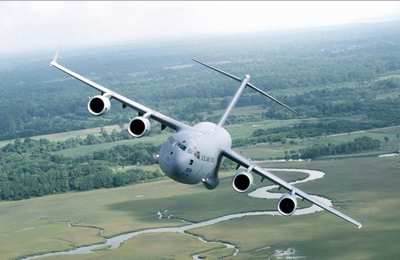Sharing Program Gives 14 Nations Access To Heavy-Lifters
Affectionately named the "Moose," the C-17 cargo aircraft is
close to finding a new home at Papa Air Base, Hungary. After years
of planning, 14 NATO members and partners are only a few signatures
away from gaining access to three C-17s to share for their national
requirements, to include NATO missions in Afghanistan.

"Some countries don't have enough [need for] airlift to purchase
their own C-17s," said Peter Flory, assistant secretary general for
NATO's Defense Investment.
The solution is to share the C-17s. The initiative, called NATO
Strategic Airlift Capability, allows the 14 nations to draw on the
aircraft's capabilities at a fixed rate.
First, all the nations must sign a memorandum of understanding.
Then they pay the acquisition cost. After that, they only have to
pay the operating cost at the end of each year. The nations then
request flight hours with an operations team located at Papa
AB.
The team at Papa factors in time between aircraft usage for
emergency use. The nations also can trade their flight hours with
other nations in the group. If maintenance is required, the
consortium will pull the costs from its operating budget to repair
the problem.
The decision to use C-17s for the initiative was made with the
capabilities available at the time, said a US defense advisor to
the European Union. NATO countries were looking for an aircraft
that could carry large cargo and land while under combat and on
short runways. The C-17s fit that description.
The C-17s are being offered by US company Boeing at a reduced
price, marking the first time these countries are purchasing
US-made avionics.
According to Boeing, the recommended use of the C-17 is 1,000
flight hours a year, which gives the aircraft a life expectancy of
30 years.
"In an ideal situation, the C-17 can go a distance of 2,400
kilometers and up to 28,000 feet and can land on a short runway as
long as it's strong," said US Air Force Col. John Zazworksy,
commander of the NATO Heavy Airlift Wing at Ramstein Air Base,
Germany, and commander of C-17 operations for the Strategic Airlift
Capability at Papa Air Base.
 "The C-17 was designed around the
cargo load. It can convert to airline or cargo seats. It can handle
a combination of passengers, vehicles, track vehicles, cargo,
medical evacuations, hummers, fire trucks, helicopters, an Abrams
tank -- up to 80,000 metric tons," he said.
"The C-17 was designed around the
cargo load. It can convert to airline or cargo seats. It can handle
a combination of passengers, vehicles, track vehicles, cargo,
medical evacuations, hummers, fire trucks, helicopters, an Abrams
tank -- up to 80,000 metric tons," he said.
The United States will be providing personnel to operate the
NATO C-17s until each nation in the consortium is ready to handle
them on its own. "Initially, there will only be US personnel
manning the C-17s," Zazworksy said. "But with training, the
countries will be able to use their own pilots, crew, aircraft
commanders and loadmasters. It will take a year and a half to train
the countries' crew and for them to be comfortable with the C-17 to
fly on their own."
NATO and the United States will each purchase one C-17 for the
initiative. The contract calls for the 14 nations to buy the third.
However, all three aircraft will be owned by the consortium and can
be used at the nations' discretion.
NATO officials say they hope to receive the first aircraft in
November.
(Aero-News salutes US Army Sgt. 1st Class Reeba Critser,
assigned with the US Mission to NATO.)
 Unfortunate... ANN/SportPlane Resource Guide Adds To Cautionary Advisories
Unfortunate... ANN/SportPlane Resource Guide Adds To Cautionary Advisories ANN FAQ: Turn On Post Notifications
ANN FAQ: Turn On Post Notifications ANN's Daily Aero-Term (04.29.24): Visual Approach Slope Indicator (VASI)
ANN's Daily Aero-Term (04.29.24): Visual Approach Slope Indicator (VASI) ANN's Daily Aero-Term (04.28.24): Airport Marking Aids
ANN's Daily Aero-Term (04.28.24): Airport Marking Aids ANN's Daily Aero-Linx (04.28.24)
ANN's Daily Aero-Linx (04.28.24)




